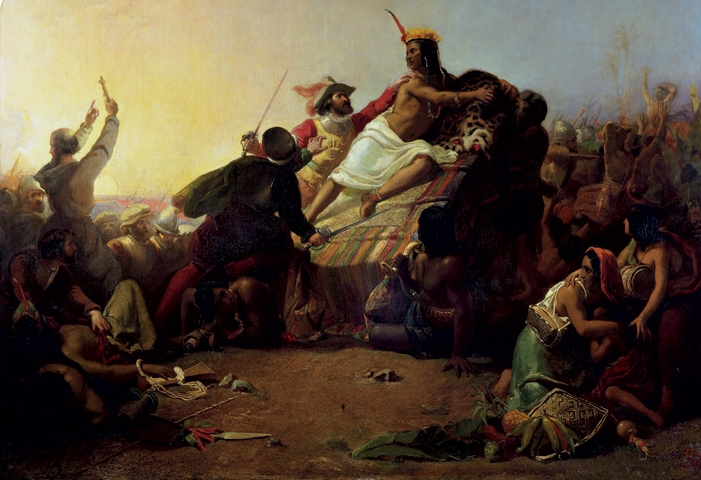Review: Guns, Germs, and Steel

“History followed different courses for different peoples because of differences among peoples’ environments, not because of biological differences among peoples themselves.”
What do Christopher Columbus, Vasco da Gama, and Francisco Pizarro have in common? Apart from their status as European countrymen, it was the fortuitous confluence of guns, microbes, and steel technology which all but ensured their success at colonizing regions occupied by peoples who lacked such historical fulcrums. It should be unsurprising, given this lethal mixture of offense, why invading states comprised of so few have been able to conquer, kill, or otherwise displace indigenous societies comprised of so many. These asymmetrical collisions suffuse human history, and it’s no secret that its retelling lends specific favor to Eurasian societies rather than those of other landmasses.
In Guns, Germs, and Steel: The Fates of Human Societies, Jared Diamond, famed anthropologist and author of The Third Chimpanzee, seeks to answer why history unfolded so differently among the various continents. Not contented with the proximate explanations above, Diamond forages deeper to uncover the ultimate explanations of why some societies procured that fateful triumvirate and why others did not. Pointedly then, why does history record Francisco Pizarro and his confederates storming the Inca Empire and capturing Emperor Atahuallpa in that momentous 1532 collision at Cajamarca instead of Atahuallpa and his band of warriors sailing east, assaulting the Spanish Empire and seizing King Charles I? Were there initial conditions which facilitated the depopulation of so much of the New World by so few of the Old?
Traditional solutions to these questions have revolved around genetic differences or innate disparities in race and intelligence. And it is these traditional explanations which Diamond hopes to sweep away. With a starting point at the tail end of the last ice age circa 13,000 years ago, Diamond takes a holistic approach to deconstructing the broad patterns of history. This is no picnic of a task. As Diamond himself points out, compressing 13,000 years of tightly coiled history into roughly 400 pages works out to “an average of about one page per continent per 150 years, making brevity and simplification inevitable.” (p. 408)
To Diamond’s great credit, Guns, Germs, and Steel represents the metamorphosis of a topic of impenetrable scope into a cohesive, well-supported and not overly prolix piece of historical literature. He begins by surveying the natural differences among the continents, noting the variations in ecological and biological diversity as well as the orientations of the main axes of the continents, all of which had deep import for the evolution of complex human societies, namely the divergence of larger food-producing cultures from smaller bands of hunter-gatherers.
As it turns out, the last ice age played a significant role in the course of our story. Compared with all other natural disasters, ice ages tend to have the most severe and lasting effects on the planet, dramatically disrupting not only climate but the chain of animal and plant life struggling to adapt to the changing circumstances. The Pleistocene drove countless of the planet’s large mammals to extinction, especially those indigenous to North America and Australia. Europe and Asia, on the other hand, suffered fewer local extinction events of their large animal species. Following the upheavals of the Pleistocene, a full thirteen of the major fourteen domestic mammals were confined to Eurasia.1 This propitious outcome presented more options for animal domestication, defined as the regulation of an animal’s breeding and food supply.
Of equal importance is the inequality of wild plant species distributed across the global landscape. Here again, one contender is lopsidedly advantaged in terms of ecological and topographical diversity. Home to the highest seasonal variation as well as the largest zones of temperate Mediterranean climate, Eurasia is saturated with the most diverse plant life.
Diamond discusses in detail the cultural shift from hunting and gathering to food-producing, emphasizing throughout that it was a gradual process. For those regions amenable to a new and more structured way of life, crop farming and pastoralism offered several benefits over the legacy lifestyle in terms of time, effort and payout. This precipitated an incremental transition from complete dependence on wild foods to a diet mainly supported by agriculture. Peoples inhabiting less fortunate regions of the globe either carried on as nomadic hunter-gatherers or were displaced by invading farmers. Australia is perhaps the best example: as the most infertile and biologically most impoverished of the continents, it has contained the largest population of hunter-gatherers into the modern era.
To illustrate the attendant, socially formative benefits of food production, Diamond enlists the reader on a voyage of deductive reasoning to link the various feedback loops at play. In low-res, highly paraphrased form, it can be sketched as follows: Whereas the hunter-gatherer existence was nomadic, food production gave rise to more sedentary societies. Farming also created food surpluses, which provided for denser human populations. With increases in human densities came a greater variety of roles to be filled within the community, facilitating the appearance of social hierarchy and political structure. At the same time, denser settlements meant more potential for crafting metal tools, inventing writing systems,2 and pioneering other technological leaps, while sedentism allowed for more time devoted to innovation and skill specialization.
In this way, food production served as a springboard for human innovation, which then radiated to surrounding populations. As the landmass with the most navigable terrain, Eurasia benefited its inhabitants by helping ease the spread of agricultural and other developments. When neighboring cultures convened to trade their goods and wares, technology and ideas were also exchanged, fostering competitive one-upsmanship and ratchet-scale modernization that would eventually sweep the region. Even more critical, when famine and other climate-triggered anomalies struck, Eurasia’s potential for east-west migration ensured that previous developments were maintained and that generational improvements in technology and social complexity kept marching onward.
The Invisible Ally
For all of its benefactions, the advent of agriculture around 8500 BCE sponsored a most pestilential side effect: increased human exposure to deadly microbes living inside domesticated animals and plants. Food-producing societies evolved resistances to these pathogens over time, or they were wiped out. First contact with foreign germs can upset the balance of a society more than any other contributing factor, and this is exactly what happened when colonizing agricultural societies encountered natives who did not share their immunities.
This was, in fact, the most important factor for each of the major collisions throughout history, including the fall of the millions-strong Aztec Empire by Cortes and his mere 600 men, as well as the largest population shift in all of human history: the initial 20 million North American indigenes being reduced by 95% in a matter of a century as a result of European conquest. In terms of their contribution to human depopulation, germs should clearly precede both guns and steel in the book’s title.
In sharp contrast with the heavily race-dependent, empirically vacuous speculations still in circulation, Diamond’s core idea is that geographic advantage proved the decisive factor in shaping the major outlines of history. Diamond links dominant cultures to the largest native palettes of domesticable biota and to the regions most congenial to technological diffusion. Thus while literacy, political organization, firearms, advanced ship technology, and infectious disease represent the proximate causes of Pizarro’s overthrow of the Inca Empire, Vasco da Gama’s success in East Africa, and countless other population shifts throughout history, Diamond insists it was their ancestors’ home turf and enduring success in cultivating the local flora and fauna which sit at the bedrock of history’s narrative.
As is the case with any work of this breadth, any implied monolithic pattern is fraught with qualification. Diamond is careful to mention caveats throughout, such as some of the difficulties involved with homogenizing Eurasia into a unified landmass. He notes that food production should not be synonymous with monotonic progress in any one category, referencing the Japanese injunction against firearms and China’s decommission of its maritime fleet in past centuries. The many nuances introduced throughout are a testament to Diamond’s attention to detail and responsible scholarship.
Closing Thoughts
One of the most fascinating gifts of history lies in the interactions among past peoples and their ripple effects down through the ages. Guns, Germs, and Steel sits above the vault of human history, providing first-stage explanations to account for its winners and losers. To a great extent, it furnishes a new hermeneutical lens by which to view history, or at the very least a soak test for assessing historical anecdotes. While Diamond was not the first to connect environmental factors to ruling states, GGS is one of the greatest syntheses of the encompassing subject matter released to date. He debunks with crack empiricism the alternative, largely racist hypotheses for history’s manifest imbalance of power, leaving a soundly reasoned case in their stead.
I can only add to the avalanche of praise that has been directed toward this book. Guns, Germs, and Steel has forever changed the way I view history and make sense of modern society. It is an academic read, to be sure, but I found it optimally dense so as not to turn away readers less interested in every detail. Some have dispraised Diamond’s repetition of common themes, but I personally found this helpful as it allowed the material to ossify more easily in my mind. The book also serves as a model of scientific rigor, with each chapter fastidiously referenced in the ending bibliography.
If I had my say, this would be standard high school reading across the country. GGS makes the short list of books which demand to be read at least once. Polymathic in scope, unwavering in its cogency, Diamond has penned a major contribution to our historical understanding which has stood the test of time. I only wished I had read it sooner.

Note: This review is mirrored at Goodreads and Amazon.
Explore further: Guns, Germs, and Steel documentary (National Geographic)
- While Eurasia hit the zoological jackpot with the royal flush of native oxen, sheep, goats, chickens, and pigs, the New World, comparatively, had little to recommend it: the turkey (the first animal indigenous to the Americas that was brought back to Europe), the llama (not as sinewy and rugged as the oxen of Europe), and bison (incompatible temperament compared with its cloven-hoofed counterparts from Europe) were among its greatest treasures. In terms of wild plant species, the Americas flourished in maize and select tubers (e.g., potatoes), but little else.
[↩] - Writing emerged independently only very rarely, and possibly just twice: the Sumerians of Mesopotamia around 3200 BCE, known for their pictorial-style cuneiform, and the southern Mexican Indians sometime before 600 BCE. The two disputed independent appearances are Egyptian writing around 3200 BCE and Chinese writing around 2700-1300 BCE.
[↩]


Comments